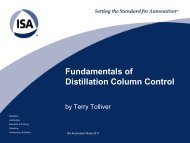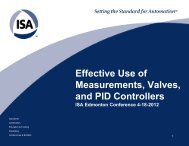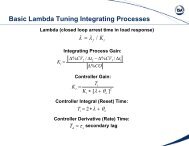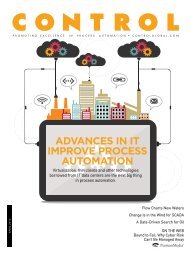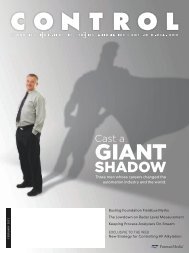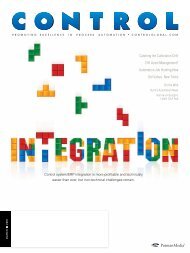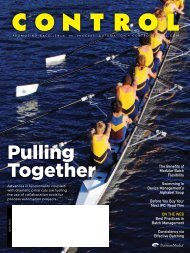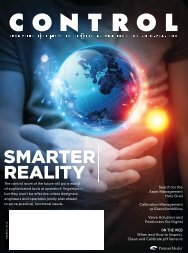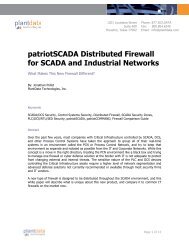April 2011 - Control Global
April 2011 - Control Global
April 2011 - Control Global
Create successful ePaper yourself
Turn your PDF publications into a flip-book with our unique Google optimized e-Paper software.
THE HIDDEN FIELDBUS<br />
NETWORK<br />
THE RIGHT TOOL FOR TRICKY<br />
MEASUREMENT JOBS<br />
ANALYZER SAMPLE<br />
SYSTEMS BASICS<br />
CT1102_01_CVR.indd 3<br />
EXCLUSIVE TO<br />
THE WEB<br />
HOW MUCH THREAT INFO<br />
DO USERS REALLY NEED?<br />
EUROPEAN PROCESS NEWS<br />
1/27/11 9:06 AM<br />
555 W. PIERCE RD., SUITE 301 • ITASCA, ILLINOIS 60143<br />
administrative team<br />
President & CEO: JOHN M. CAPPELLETTI<br />
Vice President: JULIE CAPPELLETTI-LANGE<br />
VP, Circulation: JERRY CLARK<br />
publishing team<br />
Group Publisher/VP Content: KEITH LARSON<br />
klarson@putman.net<br />
Midwest/Southeast Regional Sales Manager: GREG ZAMIN<br />
gzamin@putman.net<br />
630/551-2500, Fax: 630/551-2600<br />
Western Regional Sales Manager: LAURA MARTINEZ<br />
310/607-0125, Fax: 310/607-0168<br />
lmar tinez@putman.net<br />
Northeast/Mid-Atlantic Regional Sales Manager: DAVE FISHER<br />
Inside Accounts Manager: POLLY DICKSON<br />
Ad Traffic Supervisor: ANETTA GAUTHIER<br />
508/543-5172, Fax 508/543-3061<br />
dfisher@putman.net<br />
pdickson@putman.net<br />
agauthier@putman.net<br />
Subscriptions/Circulation: JERRY CLARK, JACK JONES<br />
foster reprints<br />
Reprints Marketing Manager: JILL KALETHA<br />
888/64 4-1803<br />
1-866-879-914 4 ex t. 168, Fax 219.561.2019<br />
jillk@ fosterprinting.com<br />
editorial team<br />
Editor in Chief: WALT BOYES<br />
Executive Editor: JIM MONTAGUE<br />
wboyes@putman.net<br />
jmontague@putman.net<br />
Digital Managing Editor: KATHERINE BONFANTE<br />
Managing Editor: NANCY BARTELS<br />
Senior Technical Editor: DAN HEBERT<br />
kbonfante@putman.net<br />
nbar tels@putman.net<br />
dheber t@putman.net<br />
Contributing Editor: JOHN REZABEK<br />
Columnists: BÉLA LIPTÁK, GREG MCMILLAN, STAN WEINER<br />
Editorial Assistant: LORI GOLDBERG<br />
design & production team<br />
Group Art Director: STEVE HERNER<br />
sherner@putman.net<br />
Art Director: DEREK CHAMBERLAIN<br />
dchamberlain@putman.net<br />
Associate Art Director: BRIAN HERTEL<br />
bher tel@putman.net<br />
JESSE H. NEAL AWARD WINNER<br />
ELEVEN ASBPE EDITORIAL EXCELLENCE AWARDS<br />
TWENTY-FIVE ASBPE EXCELLENCE IN GRAPHICS AWARDS<br />
ASBPE 2009 MAGAZINE OF THE YEAR FINALIST<br />
FOUR OZZIE AWARDS FOR GRAPHICS EXCELLENCE<br />
T E C H N I C A L LY S P E A K I N G<br />
F E E D B A C K<br />
Fieldbus Errors<br />
I enjoyed reading the article “Fieldbus<br />
Jungle,” (www.controldesign.com/industrynews/<strong>2011</strong>/018.html),<br />
but I found a<br />
number of factual errors connected with<br />
Profibus and Foundation fieldbus (FF):<br />
1. Comparing the cost of Profibus PA<br />
and 4-20mA, the author uses the example<br />
of 5 to 10 valves or transmitters for non-<br />
IS. In my experience, most non-IS designs<br />
will use 15 to 20 valves and transmitters.<br />
By the article’s argument, increasing the<br />
number of valves and transmitters would<br />
make Profibus more economical than<br />
4-20mA.<br />
2. The author states that the lead time<br />
for fieldbus devices is longer than for 4-20<br />
mA devices. This is not true for Siemens.<br />
The published lead times for Profibus PA,<br />
HART, FF and 4-20 mA option for Siemens<br />
instruments are the same.<br />
3. When designing a network the author<br />
states that you need to know within<br />
a few feet where devices are installed for a<br />
fieldbus network. The design rules in the<br />
IEC standard state a maximum limit on<br />
the spur lengths based on the number of<br />
instruments. For the most part, this is either<br />
30 or 60 meters, which gives designers<br />
a large range to work from<br />
4. The author states that troubleshooting<br />
fieldbus networks is very hard. A number<br />
of diagnostic tools are available to<br />
troubleshoot fieldbus networks. Several<br />
manufacturers—Procentec, Softing, P+F,<br />
MTL—make them and have case studies<br />
showing how easy they are to use.<br />
5. According to the author, fieldbus lifecycle<br />
costs are high because people do not<br />
understand the technology. Furthermore,<br />
it is implied that it is hard to train instrumentation<br />
people. I have been a technical<br />
trainer at Siemens for more than 10 years<br />
and have seen things change. There is no<br />
doubt that 4-20 mA is easier to teach, but<br />
people of all ages are catching on to the<br />
new technology.<br />
6. The author states that the bus wars<br />
are over and that Profibus and FF are<br />
merging. It is true that FF and Profibus<br />
organizations are now cooperating; however,<br />
I am not aware of any move to a common<br />
control bus. Given the technical differences,<br />
I am not sure if this would even<br />
be possible.<br />
7. The author stated that GSD files<br />
change often. It is possible that the author<br />
is confusing GSD files and EDD files. If<br />
you look at the case of Siemens transmitters<br />
and actuators, GSD files do not tend<br />
to change, while<br />
EDD files tend to<br />
change with each<br />
firmware revision.<br />
What that means is<br />
that you can take an<br />
old instrument and<br />
replace it with a new<br />
one without touching<br />
the control system,<br />
although you will have to update the<br />
engineering station.<br />
JAMES POWELL, P.ENG<br />
SIEMENS MILLTRONICS<br />
james.powell@siemens.com<br />
Why We Can’t All Tweet That<br />
I read with interest your recent article in<br />
the February issue of <strong>Control</strong> magazine<br />
(“What the Tweet!!?,” www.controlglobal.<br />
com/articles/<strong>2011</strong>/AutomationTweet1102.<br />
html). I agree that many social media tools<br />
can have a powerful positive effect on being<br />
able to keep up with current trends in<br />
the profession. However, there are many<br />
of us that are actively prevented from using<br />
these tools during our professional<br />
time at the office. Many companies, mine<br />
included, block any access to YouTube,<br />
Twitter and Facebook. Even LinkedIn is<br />
blocked since all “social networking” sites<br />
are not allowed. Yes, I do use my smart<br />
phone to view training videos on You-<br />
Tube, but it is not nearly as convenient as<br />
the large screen on my computer. Please<br />
don’t forget about those of us that are not<br />
able to use these tools.<br />
DEWIGHT REA<br />
ASCEND PERFORMANCE MATERIALS<br />
adrea@ascendmaterials.com<br />
[Editor’s Note: Don’t worry. We never forget<br />
here that we still have a lot of “treeware”<br />
readers. We won’t abandon you for the<br />
“shiny” of social media.]<br />
FEBRUARY <strong>2011</strong><br />
A P R I L / 2 0 1 1 www.controlglobal.com 13



